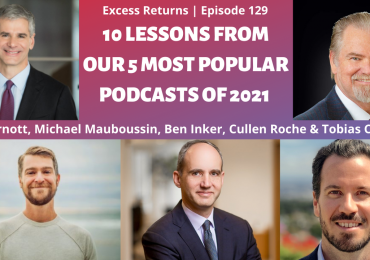In a recent interview on the Bloomberg What Goes Up podcast, Research Affiliates co-founder Rob Arnott talks about today’s market conditions and shares insights on navigating bubble territory.
Here are some key takeaways from Arnott’s comments:
- “There are always bubbles at work in the market,” and no way to know when they will burst, so Arnott advises investors to have a sell discipline in place. “If not,” says Arnott, “they are doomed to ride the roller coaster over the top and down.”
- Arnott offers the following two-part definition of a bubble: (1) valuing an asset based on discounted future cash flow requires you to use implausible assumptions to justify the current multiple; and (2) the marginal buyer doesn’t care at all about valuation models.
- Even if you believe you’re in bubble territory, Arnott warns, that doesn’t mean it’s time to short all bubble assets because “bubbles can go on for a while.”
- Both Tesla and Amazon shares are in bubble territory, according to Arnott.
- While the current low yield levels partly justify higher valuations, Arnott argues that growth has to be considered, since it is also linked to real interest rates: “When rates are low and money is cheap, growth expectations can be anemic and that has to be taken into account.”
- Arnott’s firm has been “moving back towards a defensive posture,” but he says they won’t be fully defensive until the next stimulus package is approved and that money starts to flow into the markets.
- The current dispersion between growth and value stocks is “huge” according to Arnott, who says that based on a price-to-book-value metric—which he notes is “deeply flawed”—the ratio of growth to value is now 11:1 (compared to 9:1 during the tech bubble).
- The value strategy, Arnott contends, “shines in the first few years after a bear market peters out, and it makes very little difference whether the bear market was fundamentals-related or bubble-related.”
Arnott concludes, “I have no idea when the right time is to pivot into value, but I have a strong view that value will beat growth handily over the next five years.” The key, he says, is to choose the right value opportunities without falling prey to value traps.








